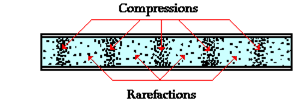Sound moves thru air by compressing and rarefying (lowering the ambient pressure) of air molecules. The waves move thru air like it is a fluid, and it is the pressure waves moving, like waves in water when you throw a rock in a pool. So it is changes in air pressure that move, transmitting the sound.
These pressure waves move at 1130 feet per second at sealevel at 70 degrees F. They have positive and negative periods, and are typically periodic, having some rate of the changes. Our ears perceive this as pitch, and we label this rate as frequency. Originally abbreviated as cps (cycles per second) we now use hertz (hz), in memory of Heinrich Hertz, a famous German scientist of the 1800s who worked with electromagnetic waves. http://en.wikipedia.org/wiki/Heinrich_Hertz
representing sound
We draw graphs that show these pressure changes to represent the amplitude of the sound, and it's frequency. These same graphs can represent the electrical equivalent of the sound waves once they are converted by a microphone into a signal we can record.
- The top image shows our molecules being compressed and rarefied in air.


